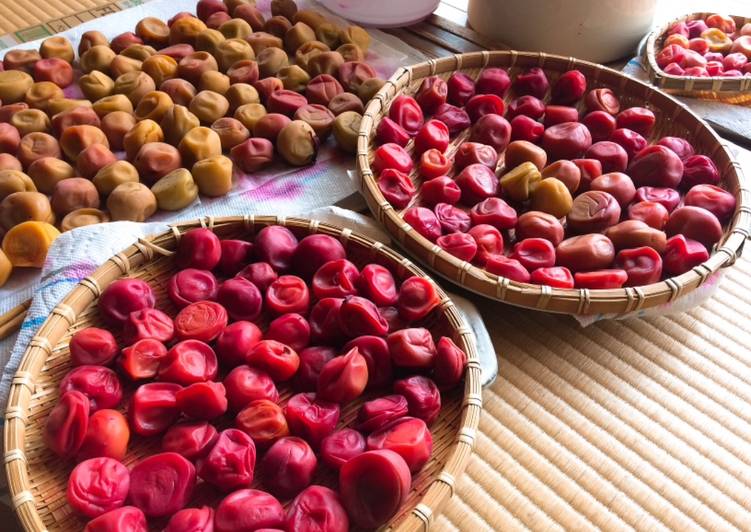Umeboshi- Japanese pickled plums / salt-preserved plums. Wash plums gently, remove hulls with a bamboo stick, and dry well with paper towels one by one. Please make sure the plums are dried well otherwise the moisture of plums will cause growing mold in the jar. Re: Homemade Umeboshi (Japanese salty pickled plums).
 Mariko Ito, thank you so much for spotlighting this treasure of Japanese cuisine!
Umeboshi are pickled (brined) ume fruits common in Japan.
The word umeboshi is often translated into English as 'salted Japanese plums', 'Japanese plums' or 'preserved plums'.
You can have Umeboshi- Japanese pickled plums / salt-preserved plums using 4 ingredients and 7 steps. Here is how you achieve that.
Mariko Ito, thank you so much for spotlighting this treasure of Japanese cuisine!
Umeboshi are pickled (brined) ume fruits common in Japan.
The word umeboshi is often translated into English as 'salted Japanese plums', 'Japanese plums' or 'preserved plums'.
You can have Umeboshi- Japanese pickled plums / salt-preserved plums using 4 ingredients and 7 steps. Here is how you achieve that.
Ingredients of Umeboshi- Japanese pickled plums / salt-preserved plums
- Prepare 2 kg of ripe plums.
- Prepare 300 g of salt.
- Prepare 300 g of Red shiso leaves (if you have).
- Prepare 2 Tbs of salt.
Umeboshi, Japanese salted plums, are a delicacy often enjoyed with rice. Here's a traditional method for making them. This recipe is reprinted with permission from Preserving the Japanese Way: Traditions of Salting, Fermenting, and Pickling for the Modern Kitchen by Nancy Singleton Hachisu. Ume (梅) or umeboshi (梅干し) is Japanese salted plums or Japanese pickled plums.
Umeboshi- Japanese pickled plums / salt-preserved plums step by step
- Wash plums gently, remove hulls with a bamboo stick, and dry well with paper towels one by one. Please make sure the plums are dried well otherwise the moisture of plums will cause growing mold in the jar..
- Place the plums in a clean jar, add the salt and mix well with a sanitized spatula or your hands with gloves on to make sure that inside of the jar is kept clean. Put plastic wrap over the plums (making it stick to the surface of the plums) and put a drop lid or flat plate on the plastic wrap. Then put 4kg weight on the plate. A few days later, you will see some quantity of water may be released from the plums, then reduce the weight to 2 kg. Leave it for a week in cool, dark place..
- One week later, you will see a lot of water released from the plum and find red shiso begins on the market.Remove the stems from the red shiso and wash it. Place the leaves into a bowl, add of salt and rub it with your hands and squeezing the leaves to remove any moisture. Do the same thing again with the last salt..
- Place the leaves into a clean bowl, add 1 cup of plum juice from the jar, mix well and put it back on top of plums in the jar. Put plastic wrap over it again (making the wrap stick to the surface of the shiso leaves) and put back the drop rid or flat plate on. No need to put the weight this time. If the jar has it's own lid, put the lid on..
- When the rainy season is over (a few weeks later from the red shiso is added to the jar), take all the plums and the red shiso leaves out from the jar, place them onto sieves or flat strainer and let them spread over sieves in a single layer. Let them sun dry, from a few hours, up to 3 days..
- Please keep the liquid. we call it ume-zu(plum vinegar) and you can use it for cooking as you use vinegar for your cooking..
- The dried plums should be kept in a sanitized jar with lid and will remain good for many years. Put the dried shiso leaves in a food processor and make it into coarse powder, then it'll be delicious furikake seasonings. (Furikake is toppings for rice. You can sprinkle furikake on your rice).
It is a popular kind of Japanese pickles (Tsukemono) and they are extremely sour and salty. We usually serve umeboshi with rice or rice balls (onigiri). Among all kinds of umeboshi, Nanko Plums (南高梅 なんこ. Hangover cures come in all shapes and sizes: the hair of the dog, a greasy breakfast, shots of espresso, and umeboshi. Japanese people suffering from the ill effects of alcohol swear by this gumball-sized, pickled stone fruit.